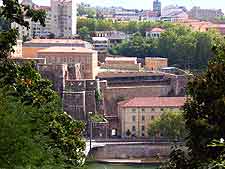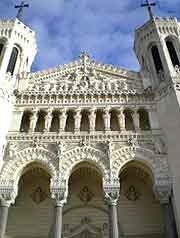Lyon History Facts and Timeline
(Lyon, Rhone Alpes, France)

The earliest origins of Lyon go back to ancient times when a Gaulish hill fort was established, known as Lugdunon. The name is thought to derive from the Celtic sun god 'Lugus'.
In 43 BC, the Romans founded a colony on the site. Lugdunum symbolised the colonial might of the Roman Empire. Indeed, it became the capital of the Three Gauls territory. When the Romans left the area, Lyon fell into decline and, over the course of the centuries that followed, it fell victim to successive Barbarian invasions.
From Medieval Times to the French Revolution
Lyon survived these 'dark ages', however, and by the 11th century, had become an important urban centre. In 1078, it was proclaimed the seat of the Primate of the Gauls. Its status and influence gave it a new lease of life, with many of its churches and abbeys being rebuilt. Although the city was annexed to the Kingdom of France in 1312, taking away its independence, Lyon held on to its economic successes.
It was at the end of the 15th century when Lyon really came into its own. The establishment of the first printing presses here in 1472 can be said to have changed the course of the city's history. The city became one of the leading centres for publishing in Europe. From the middle of the 16th century, silk weaving also became a key industry. During the next 200 years, Lyon achieved real prosperity, with its pre-eminence as a silk producer remaining unchallenged. The popular trade fairs in the city soon became the talk of Europe.
The Arrival of the French Revolution
The French Revolution put an end to this period of prosperity. In 1793, troops came to seize the city and destroy its buildings, as a consequence of the city's support of Girondists against the National Convention. The Revolution led to numerous deaths in the city. Many of its buildings were damaged and any hopes for expansion were firmly quashed, for the time being at least.

History From the 19th Century to the Present Day
The early 19th century was characterised by workers unrest in Lyon. Beginning in 1831, three silk weavers riots took place here, known as the Canut revolts. This was a time of economic depression and the silk weavers were keen to agree a fixed price for their goods, in a market where prices were falling. The third and final revolt occurred in 1848, a year of revolution not just here, but throughout Europe.
By the mid-19th century, Lyon had expanded into the surrounding countryside, absorbing many small neighbouring villages. The city was home to around 340,000 people, with an astonishing 100,000 looms at work. Many of these were operated in the Croix Rousse district of the city.
In 1870, the Lumière family moved to Lyon. Brothers Louis and Auguste soon became interested in a new cinematic invention. They shot their first moving picture in 1895, choosing to capture for posterity their father's employees leaving the factory at the end of the day. Their first public screening that year marked the birth of cinema.
During World War Two history, many of the city's inhabitants were killed, including Jean Moulin, a leader in the French Resistance. Many others were deported on the orders of Klaus Barbie, who became known as the 'butcher of Lyon'. In 1944, the Germans retreated from the city and Barbie was eventually put on trial.
In recent years, Lyon has striven to improve its infrastructure. In 1989, Interpol, the world's largest international police agency, set up its headquarters in the city. However, it has also struggled to come to terms with its large immigrant population. Today, Lyon has emerged as a cosmopolitan city, balancing its aspirations for the future with its turbulent past.
 The earliest origins of Lyon go back to ancient times when a Gaulish hill fort was established, known as Lugdunon. The name is thought to derive from the Celtic sun god 'Lugus'.
The earliest origins of Lyon go back to ancient times when a Gaulish hill fort was established, known as Lugdunon. The name is thought to derive from the Celtic sun god 'Lugus'.